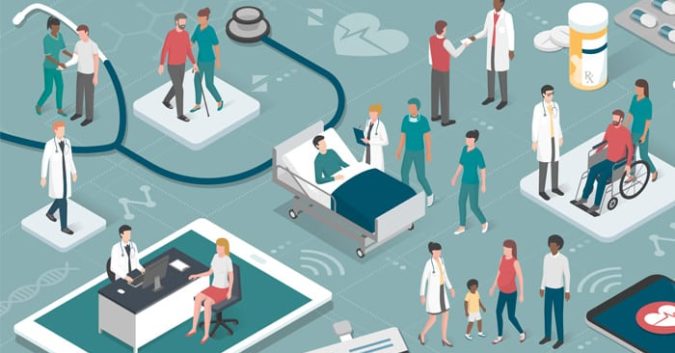The mortality rate from medical malpractice in the United States is alarmingly high, ranking as the 3rd leading cause of death. Part of the reason for this statistic may be physician fatigue, burnout, and emotional exhaustion. One way to decrease medical malpractice may be to relieve the strain on doctors working in an overburdened system.
These changes could include shifting some of their workload to other healthcare providers, redesigning electronic medical record (EMR) systems, and helping doctors engage in self-care. If physicians are able to care for themselves, this will lead to better care for patients.
Diagnosing Burnout
According to a recent Medscape survey of physicians, 45 percent of doctors in emergency departments and 42 percent of doctors overall report that they are burned out. This entails feeling emotionally exhausted, cynical, and ineffectual at work. The burnout rate is twice that of other professions in the U.S., and may also explain why doctors have the highest suicide rate of any career.
According to a Mayo Clinic survey of 7,000 doctors, 1 in 5 were going to decrease the amount of time they spent seeing patients over the next 5 years, and 1 in 50 had decided to leave medicine in the next 2 years. Roughly 25 percent of doctors plan to retire over the next decade, as the Baby Boomer generation continues to grow older and need more complex care.
The supply of new doctors might also be shifting, since last year the number of applications to medical schools dropped by 14,000. The Association of American Medical Colleges (AAMC) has projected a need for 100,000 additional doctors by 2030.
To work against this decrease, Congress passed the Resident Physician Shortage Reduction Act, increasing residency slots by 15,000 over 5 years. In some medical programs students will be able to specialize earlier, and the length of program will be reduced. Yet improving the supply of doctors does not remedy many problems in the medical system that have led to less-than-quality care.
The Pitfalls of E-Medicine
One cause of physician burnout has been EMR systems that are supposed to enable centralization and sharing of patient information. Yet many regulations govern medical records, including how they can be used, and who may see them. At the same time, there is an ever-increasing number of patients at medical centers.
These changes mean doctors have to spend more time on electronic documents, while juggling new duties and patients. Physicians can’t spend as long as they would like providing care, which is extremely frustrating for people who entered a helping profession. This exasperation leads to burnout, leaving doctors less efficient and effective, and more likely to make mistakes.
Error Epidemic
According to an 8-year study released in 2016 by Johns Hopkins University, medical errors result in over 250,000 deaths annually. Only heart disease and cancer take a worse toll on the American public. Other studies suggest the medical error mortality rate could even be as high as 440,000 deaths per year, since many errors are never documented.
Seemingly minor omissions may lead to catastrophic problems, such as not asking a patient about pre-existing conditions, or neglecting to inform a patient about things they should not do while recovering from an illness or procedure. These are easy mistakes to make when one is burned out, yet the problem is magnified since medical culture doesn’t allow doctors to admit medical errors so procedures can be improved.
Our healthcare system must change to allow care providers to work together, and be able to catch problems before they have serious consequences.
A Prescription for Teamwork
One solution is for care providers who are not doctors to complete some of their tasks, such as taking notes on a patient’s medical history, and details of their physical exam. Not only does this system lead to a better written record, doctors report they are able to focus on the patient and provide more thorough and efficient care.
Nurse practitioners and doctor’s assistants are also spending more time with patients, doing things such as discussing their medical condition, and changes to their diet and exercise routine. This allows patients time to digest information and ask questions, while doctors devote their attention to determining treatment options. Employment of nurse practitioners and doctor’s assistants is on the rise, and expected to grow by 30 percent in the next decade.
In additional to working more closely with other health care providers, physicians also need to invest time in making patients active partners in their own care. Patients should be well-educated about their condition, so they can work with their physicians in choosing the best course of action.
Shift the Shifts, Write a Poem
At a recent National Academy of Medicine (NAM) conference, one panel focused on changes hospitals have made to ease stress on physicians and prevent burnout. Some hospitals adjusted when shifts begin and end, realizing that affected the time doctors could spend with spouses and children.
Other hospitals have incorporated mindfulness training, meditation, and promoted the benefits of the arts, such as painting and writing. These stress-relieving tactics can help healthcare professionals release some of the grief and frustration that leads to burnout.
Medical Record Flexibility
While EMRs can be useful, they may also create errors when patient data is not transmitted. EMR design and function must change to help physicians better care for patients, since now they are formatted to help with billing. A more flexible EMR system would allow health care providers to share information about patients, and identify pressing issues in that patient’s care.
Some hospitals are working on a team-based approach to EMRs, allowing a wider range of treatment professionals to add data. While a few doctors have been uneasy about letting go of control, collaborative systems grant health care providers an opportunity to learn from each other and prevent mistakes.
Incorporating these strategies into the healthcare system will allow physicians to better care for themselves, and in turn provide the best possible service to their communities.
